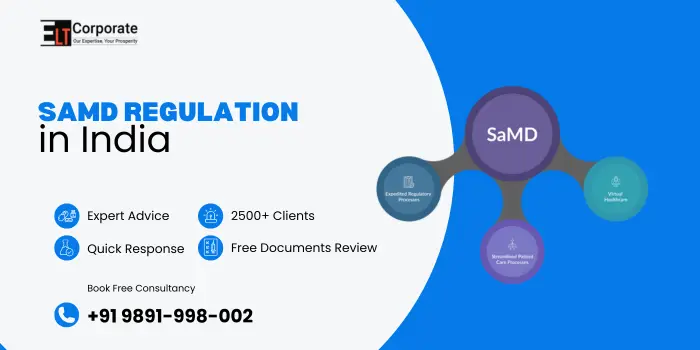SaMD Regulation in India 2025 refers to the legal and compliance framework that governs Software as a Medical Device (SaMD) in the Indian healthcare system. SaMD means software that performs medical functions, such as diagnosing diseases, analyzing scans, or monitoring health- without being part of a physical medical device.
Since digital health technologies are growing rapidly, SaMD regulation is necessary to ensure patient safety, data security, and compliance with global standards. In 2025, India is aligning its SaMD regulation with international guidelines from IMDRF, FDA, and EU MDR, while adapting them to Indian needs under the Medical Device Rules, 2017 (MDR 2017) managed by the CDSCO.
What does SaMD Regulation in India 2025 mean?
SaMD Regulation in India 2025 means the set of rules, approvals, and compliance requirements that software companies, device manufacturers, and healthcare providers must follow if their software is considered a medical device.
- It covers registration, classification, testing, quality assurance, and approvals.
- SaMD includes AI-based diagnostic tools, health monitoring apps, and imaging analysis software.
- Regulation ensures that only safe, effective, and high-quality software reaches Indian hospitals and patients.
Why is SaMD Regulation in India 2025 important for healthcare and patient safety?
SaMD Regulation in India 2025 is important because it protects patients and ensures digital healthcare tools are trustworthy.
- Protects patients – Prevents unsafe or inaccurate software from being used.
- Improves quality – Makes sure SaMD is tested and validated before use.
- Encourages innovation – Provides clear rules for startups and companies.
- Supports digital health growth – Helps India adopt AI, machine learning, and telemedicine safely.
Example: An AI-based diabetes monitoring app must be regulated to avoid wrong dosage recommendations.
Which authority is responsible for SaMD Regulation in India 2025?
The main authority for SaMD Regulation in India 2025 is the Central Drugs Standard Control Organization (CDSCO), which operates under the Ministry of Health and Family Welfare.
Other supporting authorities include:
- MoHFW – Creates healthcare policies.
- MeitY (Ministry of Electronics and IT) – Ensures digital security standards.
- FSSAI (for nutrition-related SaMDs) – In cases like diet apps or calorie calculators.
How does CDSCO manage SaMD Regulation in India 2025?
CDSCO manages SaMD regulation through a structured approval and monitoring process:
- Classification of SaMD (Class A–D based on risk).
- Review of documents like clinical evaluation reports, risk assessments, and technical details.
- Granting licenses through the Sugam Portal.
- Post-market surveillance – Monitoring performance and complaints after approval.
- Audits and inspections – Ensuring companies follow MDR 2017 and ISO standards.
What are the classification rules under SaMD Regulation in India 2025?
SaMD Regulation in India 2025 follows risk-based classification, similar to IMDRF and EU guidelines:
- Class A (Low Risk): Software that provides simple health information, like fitness apps.
- Class B (Moderate Risk): Software for monitoring conditions, like heart rate tracking apps.
- Class C (High Risk): Software assisting in diagnosis, like AI for X-ray analysis.
- Class D (Critical Risk): Software that makes treatment decisions, like radiation therapy planning tools.
The higher the class, the stricter the approval process and longer the review timeline.
What documents are required for compliance with SaMD Regulation in India 2025?
To comply with the SaMD Regulation in India 2025, companies must submit:
- Application form via the CDSCO Sugam Portal.
- Device/Software description.
- Intended use statement.
- ISO 13485 certification (quality management).
- Clinical evaluation reports (if applicable).
- Risk management file (ISO 14971).
- Data privacy and cybersecurity plan.
- International certifications (FDA/CE, if available).
How do global guidelines impact SaMD Regulation in India 2025?
Global guidelines strongly influence India’s SaMD regulation:
- IMDRF framework – India aligns with global definitions and risk-based classification.
- US FDA guidance – Provides standards for AI-based SaMD.
- EU MDR rules – Inspire India’s approach to clinical evaluation.
- WHO recommendations – Ensure global health safety alignment.
This helps Indian SaMD companies enter international markets more easily.
What challenges exist in implementing SaMD Regulation in India 2025?
Some challenges include:
- Lack of clear standards for AI/ML-based SaMDs.
- Limited awareness among startups.
- Delays in regulatory approvals.
- Shortage of skilled reviewers at CDSCO.
- Managing data privacy and cybersecurity risks.
How does data privacy and cybersecurity relate to SaMD Regulation in India 2025?
Data privacy and cybersecurity are key parts of SaMD regulation because these devices handle sensitive patient information.
- Encryption of patient data is required.
- Access control & authentication prevent misuse.
- Data storage rules (like India’s data protection law) apply.
- Prevents cyberattacks and hacking risks.
Without proper data protection, patients could lose trust in digital healthcare.
What are the benefits of clear SaMD Regulation in India 2025 for manufacturers and patients?
Clear SaMD regulation benefits both companies and patients:
For manufacturers:
- Faster approvals when rules are clear.
- Easier global acceptance.
- Reduced compliance risks.
For patients:
- Safe and reliable medical software.
- Trust in digital health solutions.
- Better access to innovative healthcare apps.
Why is professional consultancy important for SaMD Regulation in India 2025 compliance?
Professional consultancy plays an important role in SaMD Regulation in India 2025:
- Helps companies classify their SaMD correctly.
- Prepares documents as per CDSCO guidelines.
- Reduces delays and chances of rejection.
- Guides in handling CDSCO queries.
- Supports global certification (FDA/CE) for international expansion.
Is every health app covered under SaMD Regulation in India 2025?
No, only apps that have a medical purpose (diagnosis, monitoring, treatment) are regulated.
How long does it take for SaMD approval under SaMD Regulation in India 2025?
For low-risk Class A & B SaMDs – around 6–12 weeks.
For high-risk Class C & D SaMDs – 6–12 months.


Comments are closed